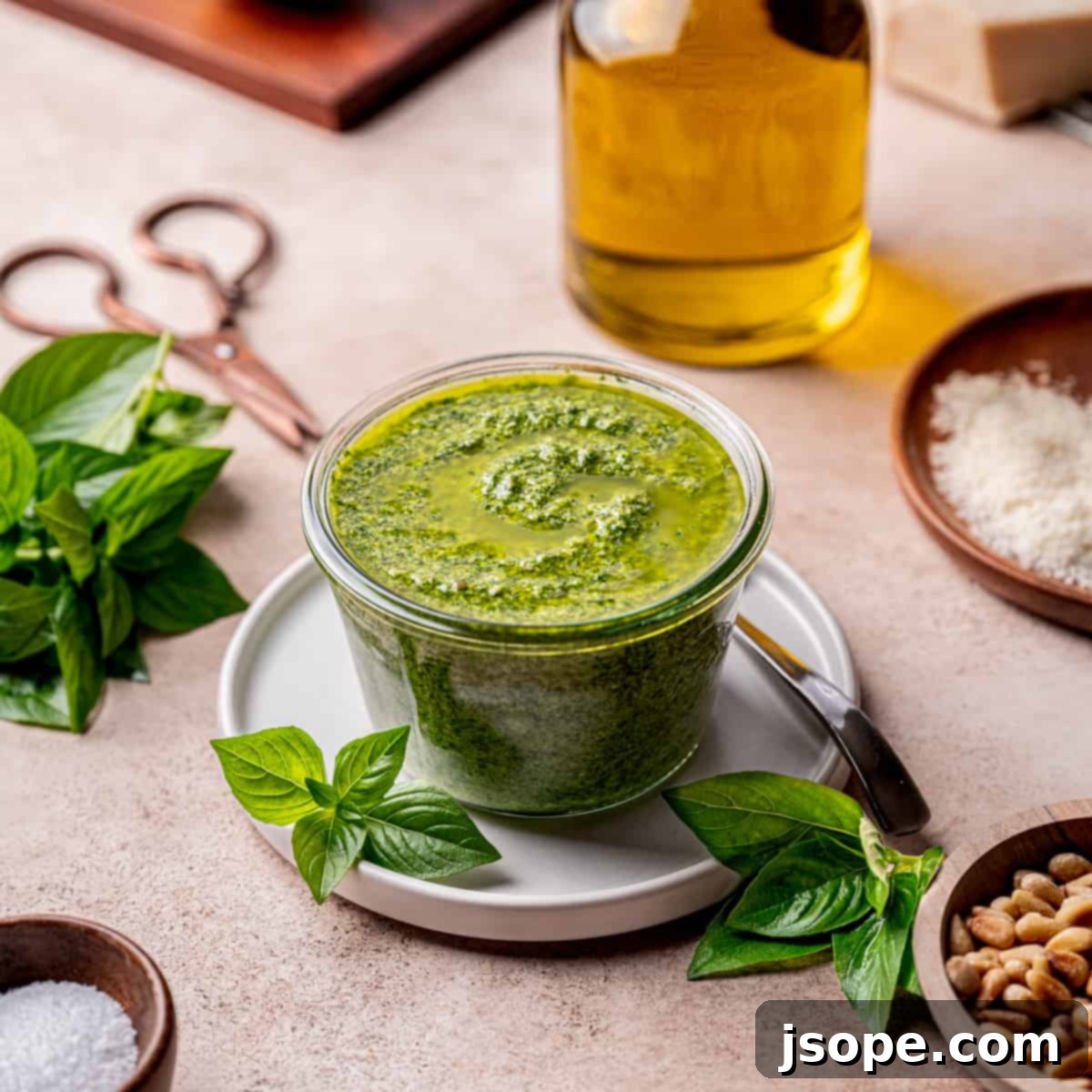The Ultimate Guide to Homemade Basil Pesto: Quick, Easy, and Delicious
There’s an undeniable charm and unparalleled freshness that comes with creating culinary delights from scratch. Among these, homemade pesto stands out as a true testament to the beauty of simple, high-quality ingredients transformed into something extraordinary. Forget the jarred versions; once you experience the vibrant flavors of freshly made basil pesto, there’s simply no going back. It’s incredibly quick and easy to prepare, and the taste is profoundly delicious, making it an essential staple in any home cook’s repertoire.
For those fortunate enough to cultivate their own herbs, growing basil in the summer yields an abundant harvest that practically begs to be made into pesto. Our basil plants often grow so vigorously that we find ourselves needing to whip up batches of this verdant sauce regularly just to keep up! While there are countless variations to traditional basil pesto, the original, classic recipe remains an absolute favorite. This guide will walk you through crafting a truly exceptional Quick and Delicious Homemade Basil Pesto that you and your loved ones will adore.
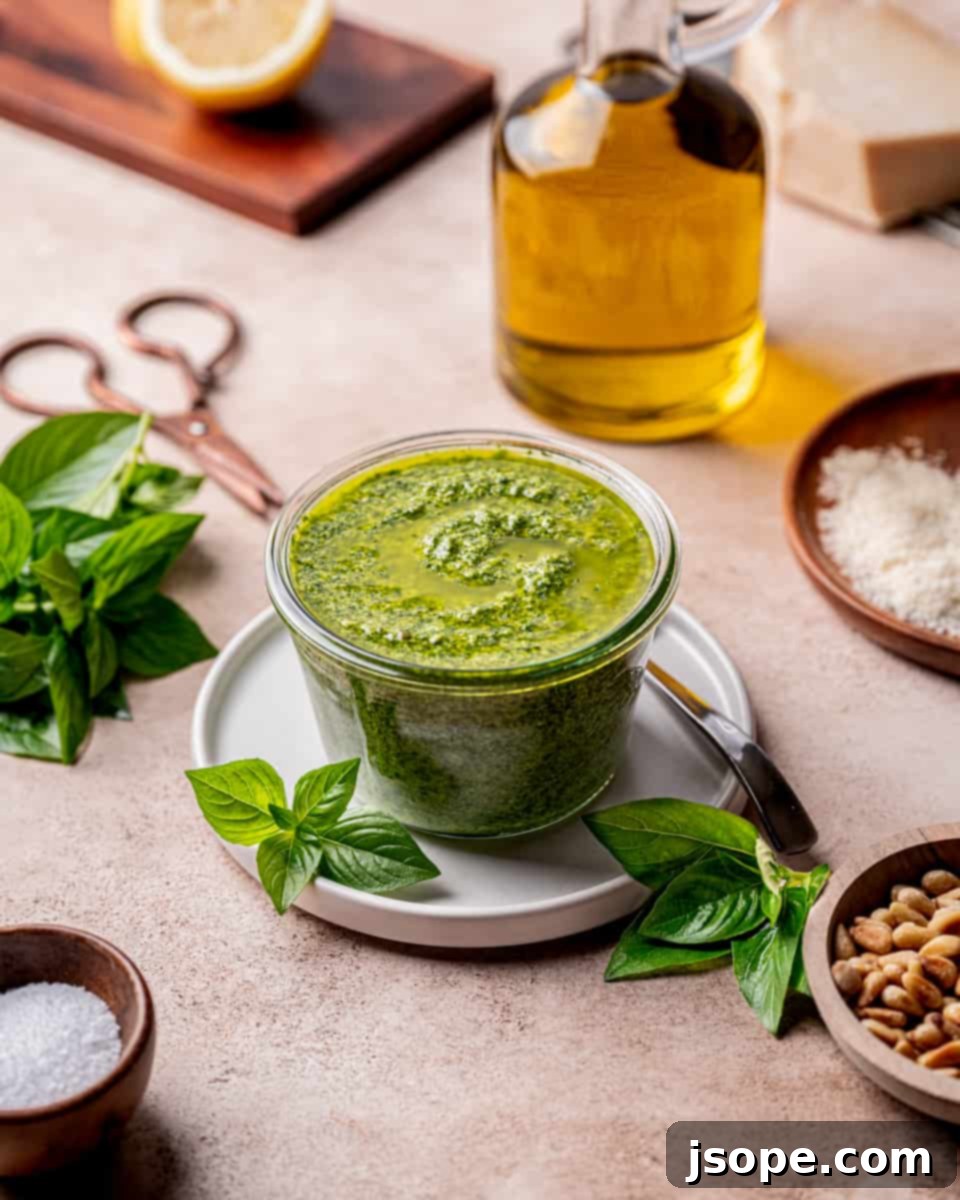
A Journey Through Pesto’s Rich History and Origins
The story of pesto is deeply rooted in the culinary traditions of Italy, specifically originating in Genoa (hence its full name, Pesto alla Genovese) on the picturesque west coast of the country. While the basil-centric pesto we know today likely gained widespread popularity in the 1800s, the concept of a vibrant, crushed sauce has a much longer history. Versions of similar pounded mixtures, often featuring garlic, nuts, and other local ingredients, can be traced back to the Middle Ages and even ancient Roman times, highlighting humanity’s age-old practice of combining fresh produce into flavorful condiments.
The very word “pesto” is derived from the Italian verb “pestare,” which means “to pound” or “to crush.” This etymology speaks volumes about its traditional preparation method: using a mortar and pestle. This ancient technique, while requiring a bit more effort, allows for a unique texture and flavor development as the ingredients are gradually bruised and blended, releasing their aromatic oils and essences slowly. Modern conveniences like food processors have certainly streamlined the process, but the spirit of “pounding” fresh ingredients remains at the core of this beloved sauce.
Over the centuries, the choice of hard grated cheeses in pesto has evolved, often reflecting the regional availability and preferences. While many varieties can produce a delightful pesto, we firmly believe that authentic Parmigiano Reggiano offers an unparalleled depth of flavor, adding a salty, nutty, and umami richness that perfectly complements the fresh basil and garlic. However, don’t hesitate to experiment with different hard cheeses; each will lend its own unique character to create an equally tasty pesto tailored to your palate.
This quick and easy homemade basil pesto is incredibly versatile and can elevate a wide array of dishes. Imagine it beautifully incorporated into a creamy pasta dish, like this delightful Creamy Pesto Pasta with Seared Scallops, or spread generously on a rustic pizza, such as our Goat Cheese Pesto and Asparagus Pizza. It also shines brightly as a vibrant condiment, adding a burst of fresh flavor to hearty sandwiches and subs, like these irresistible Italian Sausage Pepper and Pesto Subs. The possibilities are truly endless when you have a batch of fresh homemade pesto on hand.
The Essential Ingredients for Authentic Basil Pesto
Crafting a truly exceptional basil pesto begins with selecting the finest ingredients. The beauty of classic Pesto alla Genovese lies in its simplicity, relying on just a handful of components to create a harmonious symphony of flavors. While exact ratios can vary slightly across different recipes, the core elements remain consistent. Here’s a closer look at what you’ll need for this vibrant sauce:
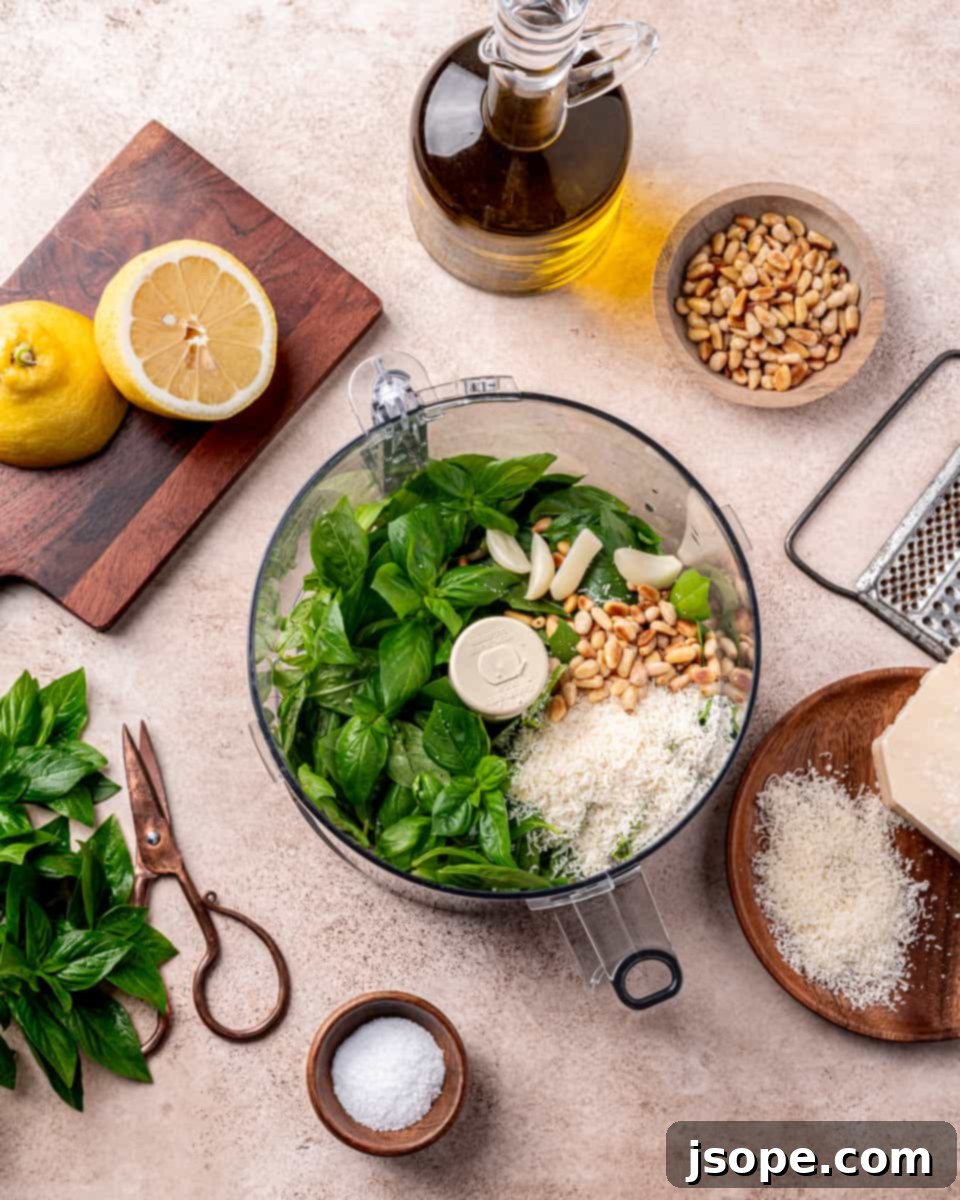
- Fresh Basil Leaves: The undisputed star of the show. For the most authentic and vibrant flavor, always opt for fresh, sweet Genovese basil or Italian basil. These varieties offer a distinct peppery, slightly anise-like aroma that defines traditional Pesto alla Genovese. Ensure your basil is bright green, free of blemishes, and harvested just before use for peak freshness.
- Pine Nuts: These small, buttery nuts contribute a delicate sweetness and a subtle richness to the pesto. Lightly toasting them before use enhances their natural flavor, adding a layer of nutty complexity that truly elevates the sauce.
- Fresh Garlic Clove: Garlic provides a pungent kick that is essential to pesto’s character. While some prefer a milder garlic flavor, a fresh clove is non-negotiable for authenticity. (See our tip below for tempering strong garlic.)
- Extra Virgin Olive Oil: As a primary component, the quality of your olive oil is paramount. Use a high-quality, cold-pressed extra virgin olive oil for the best results. Its fruity, sometimes peppery notes will infuse the entire pesto, binding all the flavors together beautifully.
- Parmesan Cheese: For that authentic Italian taste, seek out true Parmigiano Reggiano. This aged hard cheese offers a salty, nutty, and slightly sharp flavor profile that is indispensable in classic pesto.
- Kosher Salt: Salt is crucial for seasoning and bringing out the flavors of the other ingredients. We recommend Diamond Crystal brand kosher salt for its flaky texture and consistent salinity. If using Morton kosher salt, which is denser, use slightly less to avoid over-salting. Alternatively, a good quality sea salt can be used and is actually more traditional for its mineral notes.
- Lemon Juice: While not always included in the most strictly traditional Pesto alla Genovese, a touch of fresh lemon juice adds a bright, zesty note that enhances the overall flavor profile and helps to preserve the vibrant green color of the basil. We find it’s a welcome addition that provides a refreshing lift.
Please refer to the recipe card below for exact quantities.
Step-by-Step Guide: How to Make Homemade Basil Pesto
Making basil pesto is remarkably simple, especially with the convenience of modern kitchen appliances. While a mortar and pestle offers a truly traditional experience, a food processor or even a blender can yield fantastic results quickly and efficiently. We generally prefer a food processor for its ability to create a pesto with a pleasant texture – smooth yet still retaining a slight bite from the crushed ingredients. A blender can be used if you prefer a very smooth, almost puréed consistency, but for us, the food processor achieves the perfect balance.
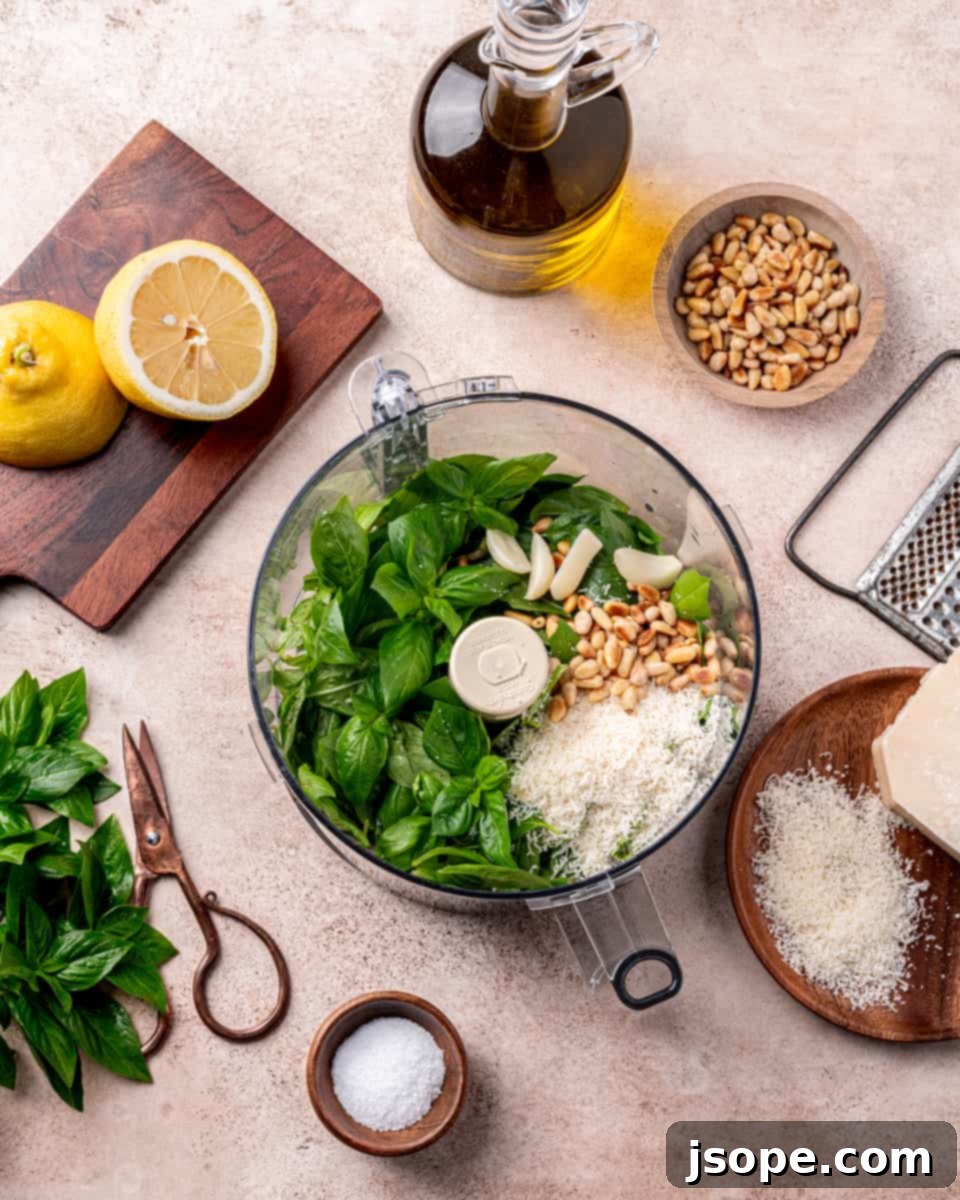
Combine all ingredients for classic basil pesto in a food processor.
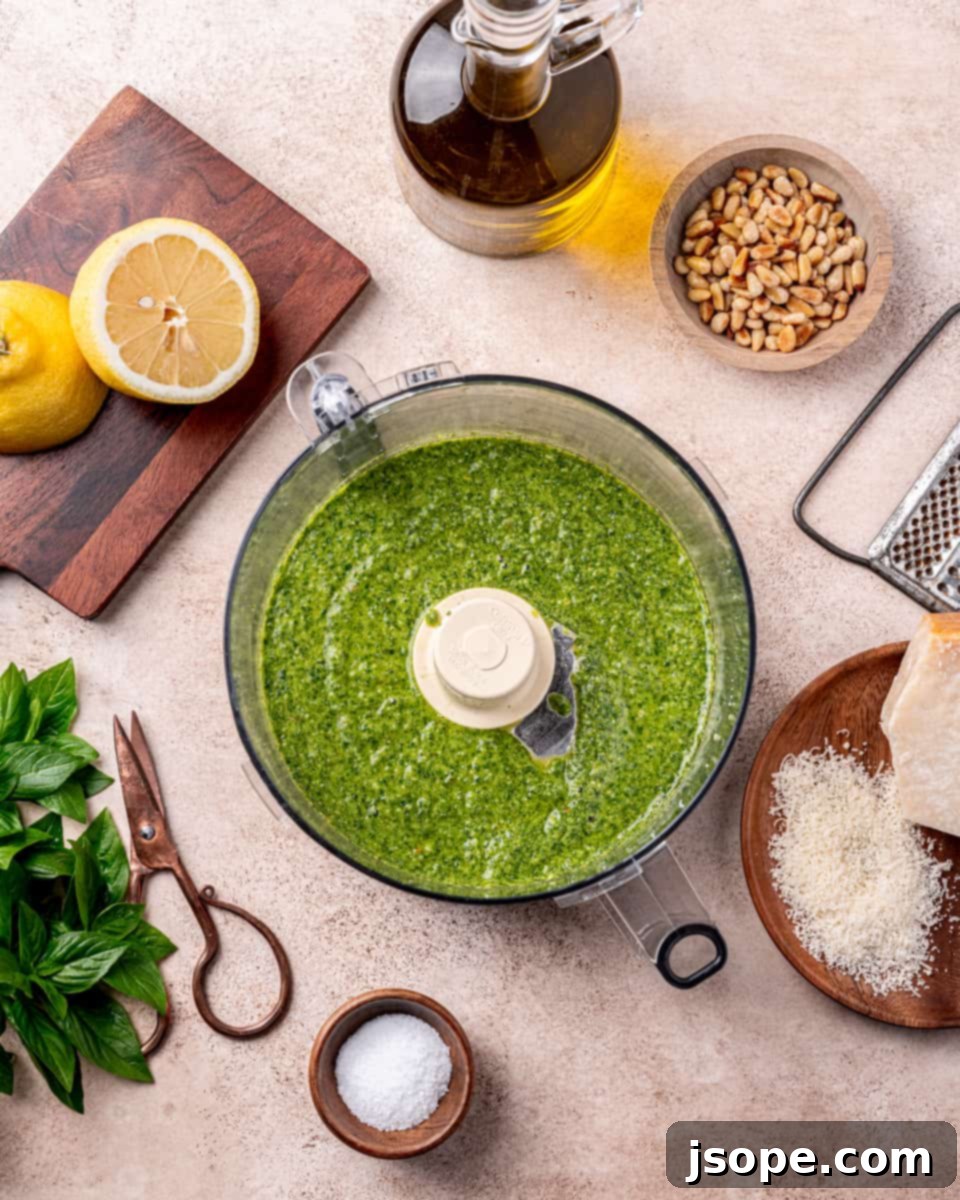
Process until smooth or until desired consistency is reached.
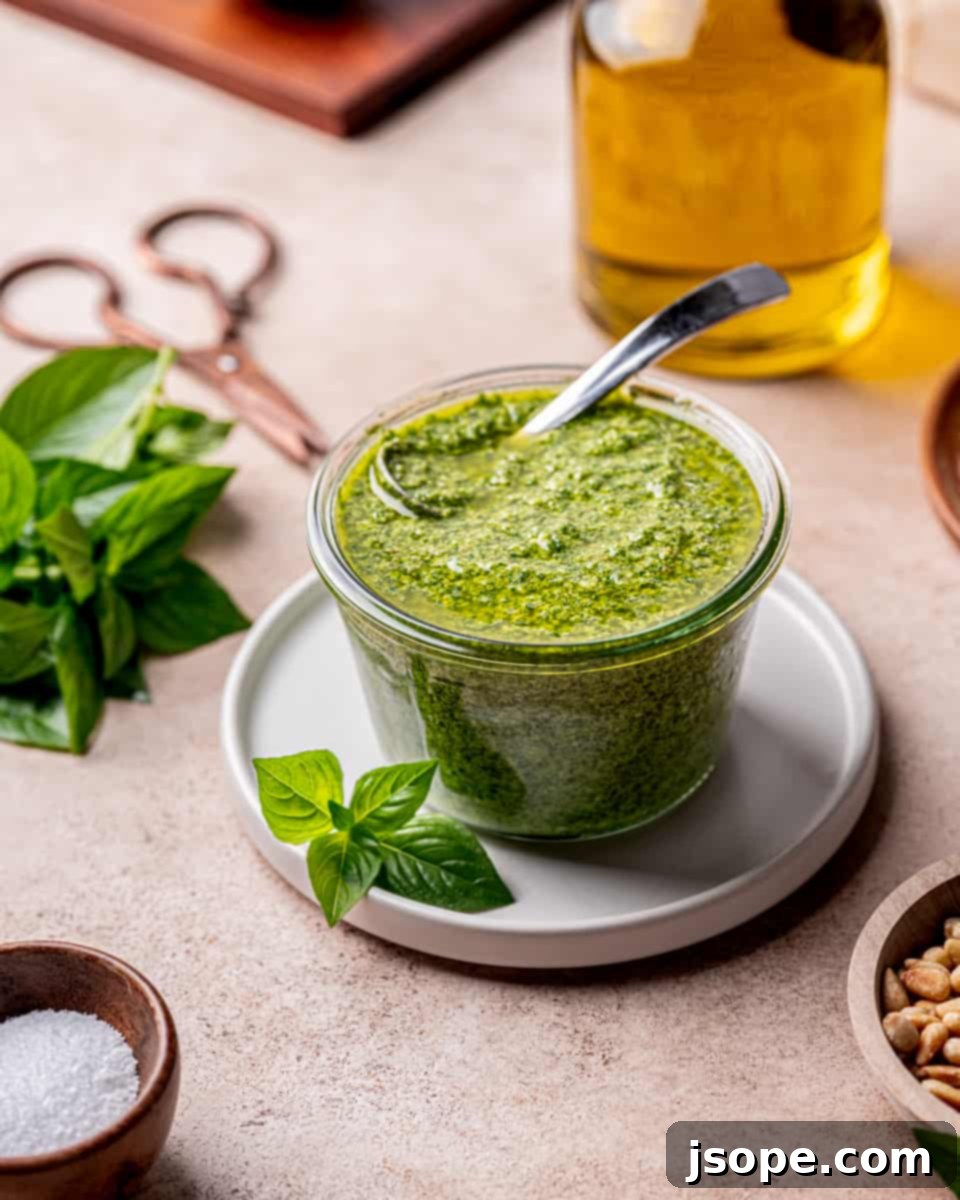
Transfer to an airtight jar, add a thin layer of olive oil on top, and store in the fridge. Use within 5 days, or freeze for up to 3 months.
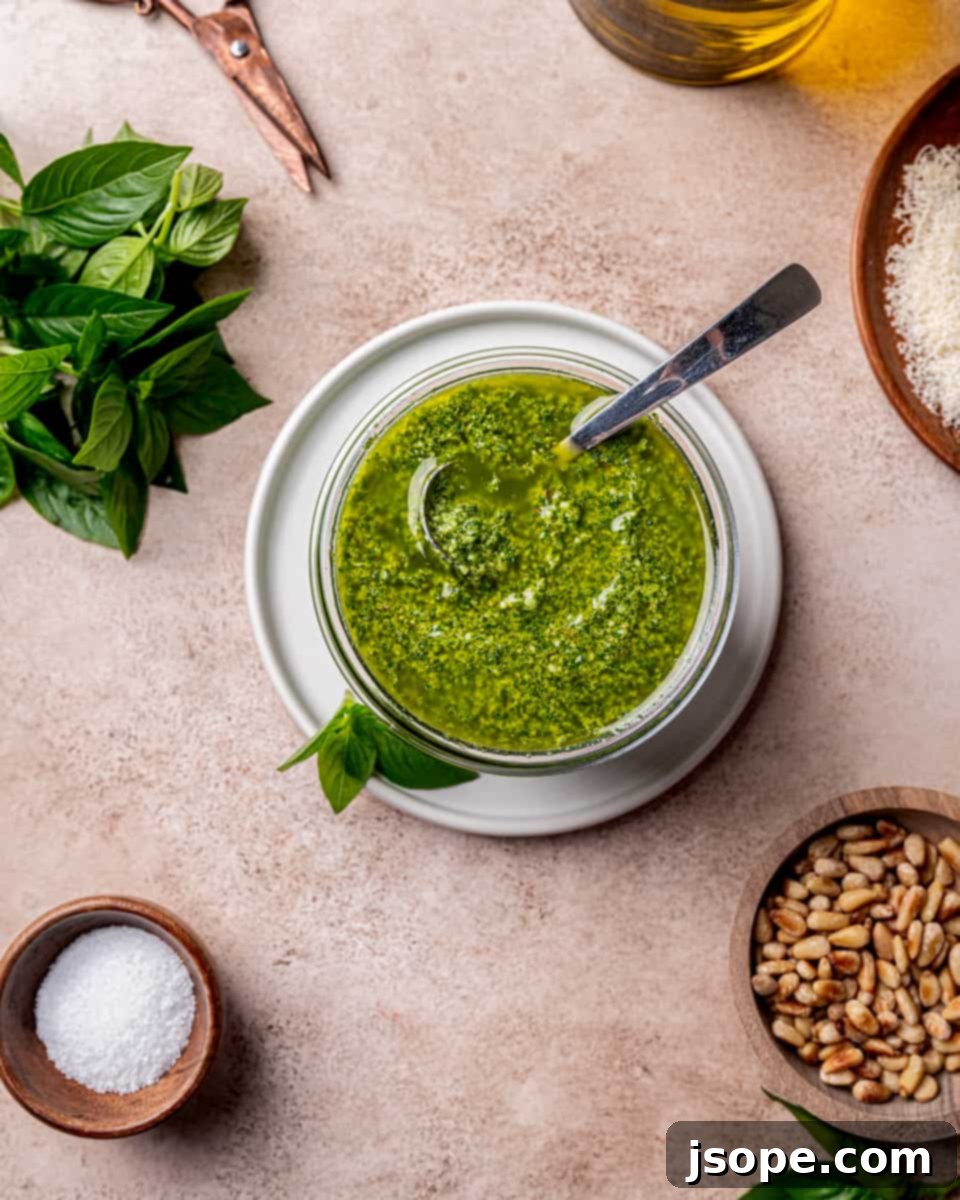
Enjoy your homemade pesto as an appetizer with crusty bread, tossed with pasta, spread on pizza, or in countless other delicious ways!
Pro Tip: Achieving the perfect pesto texture is a matter of personal preference. If you enjoy a velvety smooth sauce, a blender will yield that result. However, for those who appreciate a slightly chunkier, more rustic texture that still highlights the individual ingredients, a food processor is the ideal tool. Pulse briefly and scrape down the sides until you reach your desired consistency.
Serving Suggestions: Unleashing Pesto’s Versatility
While pesto is perhaps most traditionally and famously served with pasta or gnocchi, its vibrant flavor and adaptable nature mean it can be incorporated into an astonishing variety of dishes. Don’t limit yourself to the classics; pesto is a culinary chameleon that can elevate almost any meal.

Beyond pasta, pesto makes an incredible condiment for virtually any protein. Slather it on grilled chicken, fish, or steak, or use it as a flavorful spread in sandwiches and wraps, like our Italian Sausage Pepper and Pesto Subs. It also excels as a sophisticated dip for fresh vegetables or a luscious topping for crisp bruschetta. Furthermore, pesto pairs beautifully with just about any vegetable you can imagine – drizzle it over roasted artichokes, green beans, peas, or potatoes for an instant burst of fresh, herbaceous flavor.
Although traditional pesto is typically not cooked to preserve its fresh, bright qualities, it makes a phenomenal base for pizzas. Replace your usual tomato sauce with a generous layer of pesto for a unique and incredibly tasty pie, as demonstrated in our Goat Cheese Pesto and Asparagus Pizza. For a truly indulgent experience, we often love combining pesto with a rich cream sauce to create an exquisite pairing for seafood or chicken pasta dishes, such as our luxurious Creamy Pesto Pasta with Seared Scallops. Experiment and discover your own favorite ways to enjoy this incredible sauce!
Customizing Your Pesto: Substitutions & Variations
One of the many joys of making pesto at home is the freedom to customize it to your liking, dietary needs, or simply to explore new flavor profiles. While the classic basil pesto is a masterpiece in itself, don’t hesitate to experiment with substitutions and variations to create your own signature sauce.
Common Substitutions for Dietary Needs and Preferences:
- Pine Nuts: For those with tree nut allergies, or if you simply don’t have pine nuts on hand, excellent alternatives include pepitas (pumpkin seeds) or sunflower seeds. Lightly toasting them will enhance their flavor, just as you would with pine nuts. Other nuts like walnuts or cashews can also be used, though they will impart a different flavor profile.
- Parmesan Cheese: If authentic Parmigiano Reggiano is unavailable or outside your budget, Grana Padano or Pecorino Romano make fantastic substitutes, offering similar salty and sharp notes. A blend of these cheeses can also be delicious.
- Making it Vegan: To transform this recipe into a vegan delight, simply substitute the Parmigiano Reggiano with a high-quality store-bought vegan Parmesan alternative. Alternatively, you can omit the cheese altogether for a fresh, herbaceous “pistou” style sauce (more on that below). Nutritional yeast can also be added for a cheesy, umami depth without dairy.
Creative Variations to Explore:
Pesto is the perfect canvas for culinary creativity, allowing you to switch up ingredients and create unique flavor profiles. Italy itself boasts many regional pesto variations, though none as globally famous as Genovese Pesto.
- Use Different Nuts or Seeds: Beyond the classic pine nuts, try pistachios for a vibrant green and delicate flavor, walnuts for a bolder, earthier taste, or almonds and cashews for a creamier texture. Pumpkin or sunflower seeds also offer distinct nutty notes.
- Change the Greens or Herbs: While basil is traditional, experiment with a combination of different greens like peppery arugula or mild spinach. Incorporating other herbs such as cilantro for a fresh, zesty kick, parsley for an herbaceous brightness, marjoram for a hint of sweetness, or mint for a cooling freshness can entirely transform your pesto.
- Add Avocado: For an incredibly creamy texture and a boost of healthy fats, consider adding a ripe avocado to your pesto. This creates a wonderfully smooth sauce, perfect for spreading or dressing salads. Check out our avocado pesto recipe for inspiration!
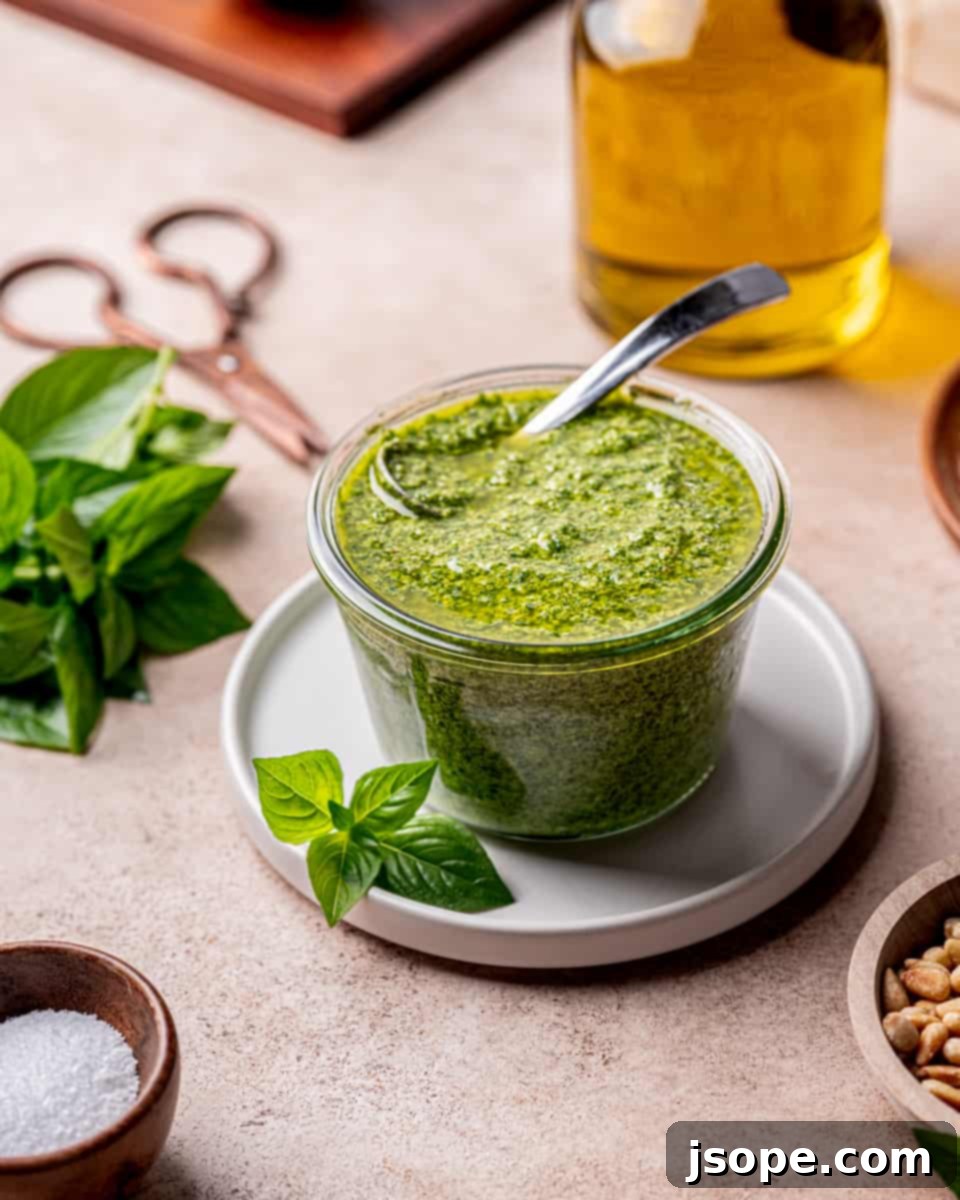
Beyond these common changes, regional variations abound. In Sicily, for instance, a vibrant red pesto, or “pesto rosso,” is popular, incorporating sun-dried tomatoes and almonds alongside basil. Further south in Italy, some versions feature bell peppers and roasted red peppers, lending a distinct smoky and sweet flavor. Our Roasted Red Pepper Pesto offers a delicious take on this southern Italian inspiration.
Venturing beyond Italy, you can find inspirations for globally-flavored pestos. A Mexican-style pesto, for example, might swap basil for fresh cilantro and pine nuts for pepitas, creating a zesty and earthy condiment perfect for tacos or grilled meats. In Southern France, a variation known as pistou is made without cheese or nuts, resulting in a lighter, saucier consistency that’s often added to soups. For an intriguing Asian twist, explore recipes like this Easy Thai Basil Pesto, which often incorporates Thai basil and other unique aromatics.
Essential Equipment for Pesto Making
While the traditional method of making pesto with a mortar and pestle offers a meditative and historically rich experience, modern kitchen tools make the process significantly faster and more convenient. For most home cooks, two primary pieces of equipment come to mind:
- Food Processor: This is our preferred tool for making pesto. A food processor allows for quick pulverization of ingredients while giving you excellent control over the final texture. You can achieve a consistency that is smooth but still retains a slight coarseness, which we find ideal for pesto, as it provides a satisfying bite and mouthfeel.
- Blender: A blender can also be used, and it’s particularly effective if you prefer a very smooth, almost puréed pesto. However, be mindful not to over-blend, as this can sometimes lead to a texture that is too uniform and can generate heat, which might slightly dull the vibrant flavor of the basil.
Both a food processor and a blender will get the job done efficiently, allowing you to whip up a fresh batch of pesto in mere minutes.
Storage Tips for Maximum Freshness
Proper storage is key to preserving the vibrant color and fresh flavor of your homemade basil pesto. Here are our top recommendations:
- Refrigeration: Transfer your freshly made pesto to a clean glass jar or an airtight container. To prevent discoloration (basil tends to oxidize and turn brown when exposed to air), pour a thin layer of good quality extra virgin olive oil over the surface of the pesto. This creates a protective seal. Stored this way, your pesto will keep beautifully in the fridge for up to one week.
- Freezing: Pesto freezes exceptionally well with minimal sacrifice to its flavor or texture, making it perfect for meal prep or preserving a large basil harvest. For easy portioning, spoon the pesto into ice cube trays. Once completely frozen, pop the pesto cubes out of the trays and transfer them to a freezer-safe zip-top bag, removing as much air as possible before sealing. Frozen pesto can be stored for up to 3 months. To use, simply thaw the desired amount in the refrigerator or at room temperature, then stir and enjoy.
Expert Tips for Perfect Pesto
To truly master homemade pesto and ensure the best flavor, keep these valuable tips in mind:
- Prioritize Ingredient Quality: Since pesto is a simple, uncooked sauce, the quality of each ingredient shines through. Invest in the best fresh basil, high-quality extra virgin olive oil, and authentic Parmigiano Reggiano you can find. These components are the foundation of an outstanding pesto.
- Temper Strong Garlic: If you’re sensitive to the sharp, pungent flavor of raw garlic, or if your garlic clove is particularly potent, you can mellow it slightly. Simply cut the garlic clove in half and boil it in water for 30 seconds to a minute before adding it to the food processor. This brief blanching removes some of the harshness without eliminating the garlic’s essential aromatic qualities.
- Avoid Over-Processing: Whether using a food processor or a blender, be mindful not to over-process the pesto. Over-blending can generate heat, which can dull the basil’s fresh flavor and potentially compromise the olive oil. Pulse in short bursts, scraping down the sides as needed, until you reach your desired consistency.
Frequently Asked Questions (FAQ) About Homemade Pesto
Is it worth it to make basil pesto from scratch?
A resounding YES! Homemade basil pesto is one of the simplest sauces to prepare at home, and the fresh, vibrant flavor is far superior to any store-bought jarred version. The difference in taste is truly remarkable, making the minimal effort entirely worthwhile.
Can I use a blender instead of a food processor for pesto?
Yes, you can certainly use a blender. A blender will typically produce a much smoother, almost puréed pesto. If you prefer a slightly chunkier texture with more character, a food processor is generally recommended. Both tools will effectively combine the ingredients.
Why does my homemade pesto turn brown?
Pesto turns brown due to oxidation, which occurs when the basil is exposed to air. To prevent this, always store your pesto in an airtight container and pour a thin layer of extra virgin olive oil over the surface before sealing it. This creates a barrier against the air, helping to maintain its vibrant green color.
How long does homemade pesto last?
When stored properly in an airtight container with a layer of olive oil on top, homemade pesto will last for about 5-7 days in the refrigerator. For longer storage, it can be frozen for up to 3 months.
Can I make pesto without nuts?
Absolutely! If you have a nut allergy or simply prefer not to use nuts, you can substitute pine nuts with seeds like pumpkin seeds (pepitas) or sunflower seeds. For a French-inspired “pistou,” you can omit nuts altogether, resulting in a lighter, herbaceous sauce.
Related Recipes You’ll Love
Looking for other delightful recipes to complement your homemade pesto or explore similar flavors? Try these:
Perfect Pairings for Your Pesto Dishes
Elevate your pesto experience by pairing your dishes with the perfect drinks. Here are some of our favorite cocktails that beautifully complement the fresh, herbaceous flavors of homemade basil pesto:
Quick and Delicious Homemade Basil Pesto Recipe

Homemade Basil Pesto
This classic basil pesto recipe is incredibly easy to make and requires just a few simple ingredients! Enjoy basil pesto as a versatile appetizer with crusty bread, mixed into your favorite pasta dishes, spread on pizza, and so much more!
5 from 2 votes
Pin Recipe
10 mins
10 mins
Sauces
Italian
4 people
245 kcal
Equipment
- 1 Food processor (or blender)
- 1 Small frying pan (to toast the pine nuts)
Ingredients
- ¼ cup pine nuts
- 1 large garlic clove, halved
- 2 ½ cups fresh basil leaves, lightly packed
- ⅓ cup extra virgin olive oil
- ⅓ cup grated Parmigiano Reggiano
- 1 teaspoon kosher salt
- 1 Tablespoon lemon juice
Instructions
- In a dry pan, toast the pine nuts until they just begin to get some color (2-3 minutes). Remove and let cool.
- Add the cooled pine nuts, garlic clove, fresh basil leaves, extra virgin olive oil, grated Parmigiano Reggiano, kosher salt, and lemon juice to a food processor. Begin processing for about 10 seconds. Use a spatula to scrape the sides of the food processor as needed. Continue to process until a uniform consistency is achieved. Taste and add more salt or lemon juice as desired.
- Transfer the pesto to an airtight glass container. Pour a small amount of extra virgin olive oil on top of the pesto to prevent it from browning due to contact with air. Store in the refrigerator.
Notes
- If you prefer a milder garlic flavor, boil the halved garlic clove in water for 30 seconds to 1 minute before using. This gentle blanching reduces the sharp assertiveness of raw garlic.
- A typical serving size for pesto is about ¼ cup per person.
Nutrition
Serving: 0.25 cup | Calories: 245 kcal | Carbohydrates: 2g | Protein: 4g | Fat: 25g | Saturated Fat: 4g | Polyunsaturated Fat: 5g | Monounsaturated Fat: 15g | Cholesterol: 4mg | Sodium: 683mg | Potassium: 105mg | Fiber: 1g | Sugar: 0.4g | Vitamin A: 843IU | Vitamin C: 3mg | Calcium: 104mg | Iron: 1mg
Tried this recipe? Let us know how it was!
Food Safety Guidelines
Ensuring food safety is crucial when preparing any meal. Please keep these general guidelines in mind:
- Always thoroughly wash all produce, especially fresh herbs, before use.
- Avoid leaving perishable foods, such as pesto, sitting out at room temperature for extended periods. Refrigerate promptly.
- If using a gas stove for toasting nuts or other tasks, ensure you have good ventilation to maintain indoor air quality.
- Never leave cooking food unattended, even for short periods.
For more comprehensive food safety information and guidelines, please refer to USDA.gov.
We sincerely hope you enjoy making and savoring this Quick and Delicious Homemade Basil Pesto Recipe! If you give this recipe a try, please share your experience and let us know how it turned out in the comments below. If you loved it, consider giving it a 5-star rating and share your final dish on Instagram, tagging us @cooking_with_wine!
